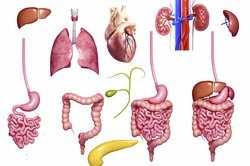What are organs?
Everyone can imagine something under the word organ. Most of the time, however, one only thinks of the heart, liver, kidneys and other prominent organs. However, organs are clearly defined and can also be found where not everyone thinks about them.

That is what we mean by organs
Organs are of course not limited to the liver, kidneys, pancreas and other easily "tangible" parts of the body. Rather, they can be found everywhere in the body - even in more hidden places.
- An organ is a functional unit of the body. It consists of functional tissue, the so-called parenchyma, and connective tissue, the goiter. The functional tissue consists of, for example, liver cells or glandular tissue. An organ is made up of tissue, which in turn is made up of cells. Several organs form an organ system, which in turn form an organism.
- An organ is present when it goes back to its own organ structure in the embryonic development and has undergone its own development. Not only more highly developed organisms have organs, but also protozoa and plants. The unicellular organelles are called organelles.
These are the organ systems
The human organism can be divided into different organ systems, which in turn are composed of different organs. The classification is not uniform - there are different systems into which the organs can be classified. The following classification is only one of several. Some organs can be counted among several organ systems.
- The cardiovascular system is an important organ system. This not only includes the heart, but also the vessels. The blood and the blood-forming organs form their own system. The respiratory system includes the lungs and trachea, and the nervous system includes the brain, the spinal cord and the peripheral nerves.
- The digestive system not only includes the digestive tract with esophagus, stomach and intestines, but also the liver and pancreas. The urogenital system can be further divided into the urinary system with kidneys, bladder and urinary tract and the genital system with the genital organs.
- The endocrine system includes all of the endocrine glands, such as the pituitary gland, adrenal glands, and pancreas. The lymphatic organs such as the spleen and thymus belong to the lymphatic system, as well as the lymph nodes, of course.
- The musculoskeletal system consists of connective, supporting and muscle tissue. These include bones, tendons, individual muscles and intervertebral discs. The skin is an organ in itself.
- Finally, there are the sensory organs, i.e. the eyes, the hearing organ in the inner ear, the tongue - and the skin is also a sensory organ.
Humans have various internal organs that maintain their vital functions ...
How helpful do you find this article?
The content of the pages of www.helpster.de was created with the greatest care and to the best of our knowledge and belief. However, no guarantee can be given for the correctness and completeness. For this reason, any liability for possible damage in connection with the use of the information offered is excluded. Information and articles must under no circumstances be viewed as a substitute for professional advice and / or treatment by trained and recognized doctors. The content of www.helpster.de cannot and must not be used to make independent diagnoses or to start treatments.

